 The only diamond mine in Russia not in Alrosa’s portfolio, Grib was developed by
the oil-and-gas
The only diamond mine in Russia not in Alrosa’s portfolio, Grib was developed by
the oil-and-gas
company, Lukoil. Last November, the U.S. Supreme Court ruled that
Archangel Diamond Corp.’s
15-year legal fight to win compensation from Lukoil for
what the company claimed was loss of its
contractual rights over Grib was at an
end. Archangel went bankrupt in 2010, having invested
US$30 million in the project
Since the last occasion when E&MJ took an in-depth look at
the world diamond industry, September 2011, the
world’s diamond producers have continued the process of restructuring
that began in the early 2000s when De Beers began
to relinquish its traditional role of industry custodian. In the
intervening period, statistics compiled by the Kimberley Process
Certification Scheme (KPCS) indicate that producers responded
in no mean way to reduced consumer demand, particularly in the
aftermath of the 2008 global economic
downturn, with output fluctuating within
a fairly narrow band between 2009
and 2015, and only showing signs of
picking up again last year.
Significant events within the industry
since 2011 have included De Beer’s
continued rationalization of its property
portfolio, reducing its interests in
South Africa and building new capacity
in Canada. And having spent a number
of years in evaluating the Bunder prospect
in India, Rio Tinto finally decided
that it was not viable and gave it away,
having also spent some $2.2 billion on
developing the underground section at
Argyle in Australia.
Winning the top spot in the producers’
league, Russia’s Alrosa clearly has
no intention of giving it up, and has
consolidated its position with new capacity
coming on stream. But perhaps
the most visible — and newsworthy —
aspect of the past six years has been the regular discovery of
large, high-value diamonds at mines run by a number of the new
generation of producers, companies that have both picked up
the discards from long-established producers such as De Beers,
and have explored, financed, developed and commissioned their
own new operations.
E&MJ’s 2011 article looked in depth at some of the background
to diamond resources, the history of production since
India ceased to be the world’s leading supplier of gem-quality
stones during the 1700s, and the world’s major diamond-mining
companies in the 21st century. In point of fact, little has
changed since then — the host rocks have remained the same,
the major producers have neither expanded nor contracted significantly, and history is history. There is thus little to gain by
repeating what was written then, and the interested reader is
directed to that article for information on those topics.
 World rough diamond production, 2004-2016 (million ct). (Source: KPCS statistics)
World rough diamond production, 2004-2016 (million ct). (Source: KPCS statistics)
Recent Production Trends
Data compiled by the KPCS covering the period from 2004 to
2016 show clearly how the world diamond industry reacted to
the wider economic malaise that began in 2008. Before that,
consumer confidence was high, and demand for both industrial
and gem-quality diamonds was good.
As shown in Figure 1, the industry reached peak output of
176.7 million carats (ct) in 2005, albeit at an average value
of $65.68/ct. The drop in output in 2006, 2007 and 2008,
while noticeable, was minor in comparison to what happened in 2009,
when production plummeted to 120.2 million ct.
Since then, weak consumer demand
has effectively put a cap on what producers
are prepared to place on the market.
From time to time, as Figure 2 illustrates,
demand has squeezed the market somewhat,
to the extent that higher average
per-carat prices have given producers an
economic boost, although the marked increase
in output from 127.4 million ct in
2015 to 134.1 million ct in 2016 merely
managed to weaken average prices from
$108.96/ct to $92.49/ct as consumers
in China and India in particular were
wary of parting with their cash.
Bear in mind that these average
per-carat prices relate to rough (uncut)
stones, with a huge differential between
the amount paid for large, high-quality
gems and run-of-the-mill industrial
diamonds. This is clearly illustrated by
considering that the average price received
by producers in the DRC last year was $10.63/ct, while
their counterparts in Lesotho averaged $1,065.88/ct. KPCS
data show that the DRC produced 23.2 million ct of predominantly
industrial-quality diamonds. Lesotho’s 342,000 ct may
have been a small fraction of that, but the country’s mines
have developed a reputation for unearthing some truly spectacular
gemstones.
 Average per-carat prices for world rough diamond production, 2004-2016 (US$/ct). (Source: KPCS statistics)
Average per-carat prices for world rough diamond production, 2004-2016 (US$/ct). (Source: KPCS statistics)
In addition, producers still have the capacity to manage their
diamond sales to a much greater extent than for most other
mined commodities. With the traditional method of sales based
around the concept of prepared packages of rough stones being
offered at “sights,” from the producer’s perspective the skill
comes in understanding what the market wants in relation to
consumer demand. Offloading surplus stock will inevitably result
in prices falling, yet for most producers there is a limit on
how much inventory they can afford to carry.
By way of illustration, Bain & Co. in the 2016 edition of its
Global Diamond Industry report for the Antwerp World Diamond
Center, noted that “Major rough-diamond producers in 2015 reacted
to the challenging circumstances of their customers by reducing
output, increasing their own inventory levels and providing
more flexible purchasing terms while cutting rough-diamond
prices. As a result, rough-diamond sales fell 24% in 2015.”
Published in the second half of the year, the report continued
“the industry rebounded in 2016. Restocking by midstream
players, following their inventory sell-off in late 2015, produced
growth of around 20% in rough-diamond sales during the first
half of 2016. However,” it warned, “strong rough-diamond sales in 2016 may again lead to swollen midstream inventories if retail
demand does not strengthen proportionately.”
Were these fears realized? According to De Beers in a report
published in June, global demand for diamond jewelry increased
marginally last year to reach a total of $80 billion, with the U.S.
alone accounting for $41 billion of this. Elsewhere in the world,
the Japanese and Chinese markets also showed growth, while
jewelry demand in India and the Middle East was weaker.
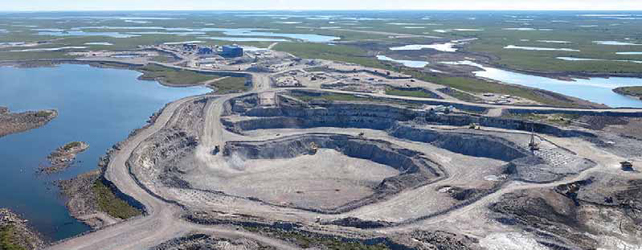 Gahcho Kué, where the De Beers-Mountain Province Diamonds joint venture began mining mid-last year, is expected to produce some 54 million ct over an initial 13-year life.
Gahcho Kué, where the De Beers-Mountain Province Diamonds joint venture began mining mid-last year, is expected to produce some 54 million ct over an initial 13-year life.
Commenting on these data De Beers’ CEO, Bruce Cleaver
said “while U.S. demand drove global growth in 2016, it is increasing
demand from emerging markets that is behind the last
five years being the strongest on record. Despite some markets
facing challenging conditions last year, we see this trend continuing,
with improvements in demand from China and India, in
particular, emerging in 2017.”
Conflict Diamonds: Still a Challenge
As E&MJ noted in its 2011 article, established in 2003, the
Kimberly Process (KP) “relies on a system of cross-referencing
production, exports, and imports of rough diamonds between producer
and consumer countries. The aim is to make it more difficult for illegally mined or smuggled diamonds to be sold to help
finance civil conflicts.” The article went on to highlight some of
the weaknesses that have been perceived in the way that the KP
operates, in particular its inability to police areas where diamond
production takes place under conflict or corrupt conditions.
Consisting of 54 participating countries and organizations,
the KP claims that 99.8% of world diamond production now
comes from conflict-free sources. Without question, it has made
major inroads into this source of income for the participants in
(usually) civil wars, but has it now been able to achieve the level
of credibility that it needs to win public confidence?
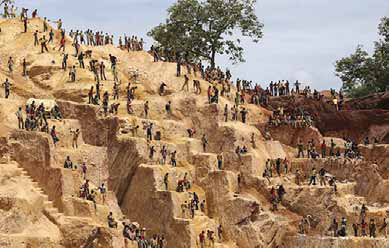 Set up to strangle the trade in conflict diamonds, the Kimberly Process suspends export
certification
Set up to strangle the trade in conflict diamonds, the Kimberly Process suspends export
certification
for the Central African Republic between 2013 and 2015. The organization
has since allowed exports
to resume from areas under government control, but critics
question the effectiveness of the way this
is policed. (Photo: Emmanuel Braun, Reuters)
That corruption can ease the way for diamonds to be awarded
fraudulent KP certification is one allegation frequently made
by its critics. An article in the U.K. newspaper, The Guardian,
in 2014 summarized other concerns. “The process has
two main flaws,” said author David Rhode. “First, its narrow
terms of certification focus solely on the mining and distribution
of conflict diamonds, meaning that broader issues are
not addressed.
“Second, a KP certificate does not apply to an individual
stone but to a batch of rough diamonds, which are then cut and
shipped around the world. Without a tracking system, this is
where the trail ends,” he added.
In fairness, the message seems to have landed on fertile
ground, with the chairman of the KP in 2016, the UAE’s Ahmed
Bin Sulayem, taking the unprecedented step of publishing a
“midterm” report on progress being made during his tenure of
the office. “Only by visiting diamond-producing countries is it
possible to fully appreciate the challenges affecting all those
involved in diamond production, from government regulators
to hundreds of thousands of miners and their families whose
livelihood depends on a transparent, accountable industry,” Bin
Sulayem said. “This work will continue.”
One of the key innovations proposed for the KP during
2016 is the establishment of a blockchain system for tracking
diamonds. Bin Sulayem’s report explained that “blockchain is
a list of transactions that happen in a peer-to-peer network.
Those who join in the blockchain can transfer value without
the need for a central third party or ‘clearer’ like a bank.
Blockchain is a distributed database, completely aligned to
the structures of the internet, which maintains a continuously
growing list of encrypted data records, secure from tampering
or revision.”
The report went on to acknowledge that “adopting blockchain
technology would be a long process requiring a great deal
of research. The cost and complexity of implementation would
also be significant,” it added. But by establishing a permanent
public record of the diamonds in the blockchain, this would create
an indisputable, unchangeable chain of ownership transfer,
replacing physical certificates with digital proof of a diamond’s
progress from mine to madame.
Russian Roundup
With an output of more than 40 million ct last year, Russia accounted
for nearly 30% of the world’s total rough diamond production,
and well ahead of the second-largest producer in volume
terms, the DRC (23.2 million ct). The other big producers, Botswana,
Australia, Canada, Angola and South Africa produced 20.5,
13.9, 13, 9 and 8.3 million ct, respectively, KPCS data show.
In its 2016 annual report, Alrosa, which
celebrates its 60th anniversary this year, reported
group production of 37.4 million
ct of rough diamonds, with sales revenues
41% higher than in 2015 at RUB317.1
billion ($4.9 billion). A key event during
the year was the reduction in the federal
state holding by a further 10.9%, bringing
it down to 33%. This followed a 16% selloff
in 2013, with the prospect of the state
selling a further 8% stake either this year
or next being mooted. However, while last
year’s sale realized $814 for a federal government
that is desperate to plug holes in
its finances, this was some $90 million less
than it had hoped for, with the Financial
Times reporting at the time that “investor
appetite was affected by poor political relations
between Russia and the West.”
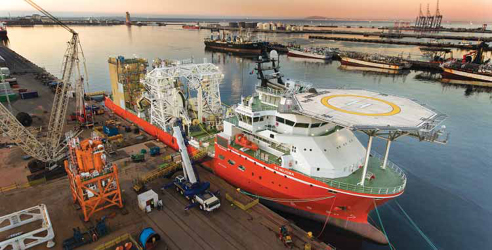 In June, Debmarine Namibia’s US$157 million SS Nujoma was named at a ceremony at Walvis Bay. The company
says
In June, Debmarine Namibia’s US$157 million SS Nujoma was named at a ceremony at Walvis Bay. The company
says
that it is the world’s largest and most advanced diamond exploration and sampling vessel. (Photo: De Beers)
On the operational side, Alrosa reported that the underground
section of its Mir mine reached its design capacity of 1 million
metric tons per year (mt/y) in 2016, and that it is starting the development
of the Zarya pipe. In addition, it began construction of the
infrastructure for the Verkhne-Munskoye deposit, with capex costs
to bring a mine into production cited at RUB63 billion ($1 billion).
While most of Alrosa’s operations are in Russia’s Far East, its
Severalmaz subsidiary has been developing the Lomonosov deposit
in the Arkangelsk district of northwest Russia. Two of the six
pipes that occur there (Arkhangelskaya and Karpinskogo-1) are in
production, with the capacity of the ore processing plant having
been increased from 1 million mt/y to 4 million mt/y in 2014.
The district is also host to the Verkhotinskoye (Grib) mine, operated
by Russia’s only other diamond producer, Arkhangelskgeoldobycha
— until earlier this year a subsidiary of the oil-and-gas company,
Lukoil, and now owned by the Otkritie Holding group. Having earned
US$314 million from rough diamond sales from Grib in 2016, Lukoil
sold the operation to Otkritie for US$1.45 billion in March.
“Lukoil successfully developed a major diamond project
from its very early stage and brought the Grib diamond
mine to almost full capacity on time and within budget.
Spinning-off of this noncore asset allows us to effectively
monetize the significant shareholder value that we have
created over the past five years,” explained Alexander Matytsyn,
Lukoil’s senior vice president for finance. The mine produced
around 4.5 million ct last year, having come on stream in
2014, and is reported to be the eighth-largest diamond operation
in the world.
Canada’s Diamond Sector Expands
Since Ekati was commissioned in 1998, Canada’s diamond
industry has grown to the extent that the country is now the
world’s fourth-largest producer. Ekati was followed by Diavik
in 2003, Jericho in 2006, and by Snap Lake and Victor in
2008. The commissioning of Renard and Gahcho Kué early
this year followed a period of consolidation within the sector.
 The 1,109-ct ‘Lesedi La Rona,’ the second-largest
The 1,109-ct ‘Lesedi La Rona,’ the second-largest
gem-quality rough diamond ever
discovered, according
to Lucara Diamond Corp. At auction last year, the
bidding
stopped at US$61 million, below the
company’s reserve price.
However, it has by no means been plain sailing for the industry,
with Jericho — Nunavut’s only diamond mine — closed as
uneconomic in 2008 and Snap Lake falling foul of high pumping
and water-treatment costs in 2015. Following this, De Beers
sought offers for the property, but having failed to do so, announced
in December that it planned to flood the mine. Snap Lake
produced 1.2 million ct in 2015, and at the time had resources to
support production until the late 2020s.
De Beers also faces challenges at its 600,000-ct/y Victor
mine in northern Ontario, where reserves in the existing
pit are expected to be exhausted by late 2018. Earlier this year
Reuters reported that the company had shelved plans to evaluate
the neighboring Tango resource, following its inability to reach
an agreement on the project with the Attawapiskat First Nation.
De Beers presumably hopes for better fortunes with its third
Canadian mine, Gahcho Kué, where it is in 51:49% joint venture with Mountain Province Diamonds. Operations at the
three-pit complex started to ramp up in August last year, with
commercial production being confirmed in early March.
Located some 280 km northeast of Yellowknife in the Northwest
Territories, Gahcho Kué operates on a fly-in/fly-out basis.
The world’s largest new diamond mine, it is based on a cluster
of four diamond-bearing kimberlites, three of which have a
probable mineral reserve of 35.4 million mt grading 1.57 ct/mt.
Commissioned at a capital cost of near $1 billion, the mine is
expected to produce an average of 4.5 million ct/y, with a 13-
year lifetime output of around 54 million ct.
Mountain Province Diamonds discovered the 5034 kimberlite
pipe at Gahcho Kué in 1995, with De Beers then adding
to the resource with the discovery of the other three pipes.
Mining is now focused on the 5034, Hearne and Tuzo pipes,
requiring the water level in the adjoining Kennady Lake to be
lowered and protective dykes and berms constructed to allow
access to them.
In all, De Beers produced just over 1 million ct from its Canadian
operations last year, markedly down from the 1.9 million ct
it won in 2015 — mainly as a result of Snap Lake having been
suspended at the end of 2015.
Meanwhile, Stornoway Diamond Corp. sneaked in ahead
of Gahcho Kué with the declaration of commercial production
at its Renard mine at the beginning of January. Situated 350
km north of Chibougamau in the James Bay region of northcentral
Québec, Renard cost Stornoway, the sole owner, C$775
million to develop.
Ore processing began in July 2016, two years after construction
began. The mine produced 2 million mt of open-pit ore
during the year, while recovering nearly 450,000 ct.
Four kimberlite pipes host the initial resource of 22.3 million
ct. Open-pit mining from the combined Renard 2 and 3 pipes will
continue until next year, and from the Renard 65 pipe until 2029.
Underground production will be from the Renard 2, 3 and 4 pipes,
with Renard 2 holding the bulk of the underground resources. Stornoway
expects to produce 1.7 million ct this year, while mining 4.4
million mt from the open pits and 500,000 mt from underground.
And the search for Canadian diamonds is by far from over,
with a number of junior companies at work. These include Peregrine
Diamonds with its Chidliak open-pit project on Baffin Island,
Dunnedin Ventures (the Kahuna project in Nunavut) and
Kennady Diamonds, which has the Kennady North landholding
near Gahcho Kué.
In June, Rio Tinto took a three-year exploration option on
Shore Gold’s long-standing Star-Orion South project in the
Fort à la Corne area of central Saskatchewan, with a $18.5
million commitment to win a 60% stake in a future joint venture. Conversely, De Beers recently
walked away from its own seven-year,
US$15.8 million option agreement with
CanAlaska Uranium in the West Athabasca
region of the province, having failed to
identify any kimberlite at targets identified
from airborne magnetic surveys.
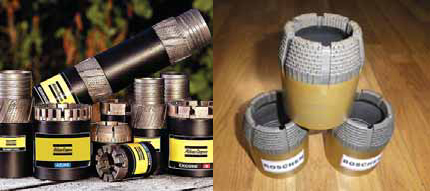 Exploration core drilling is just one end-use for industrial diamonds. Natural stones, while comprising
Exploration core drilling is just one end-use for industrial diamonds. Natural stones, while comprising
around 70%
of production, now account for only 1% of annual industrial diamond demand, with China by
far the world’s biggest
producer of synthetics. (Atlas Copco bits on the left and Roschen NQ wireline core
bits on the right.)
And in July, Dominion Diamond Corp.
(formerly Harry Winston Diamond Corp.,
formerly Aber Diamond Corp.), which has
a 40% stake in Diavik with Rio Tinto and
owns 80% of Ekati, agreed to a US$1.2
billion takeover by privately owned, U.S.-
based The Washington Cos. The new owners
have said they plan to invest in the Jay
and Fox Deep projects at Ekati, and in new
greenfield exploration.
Crystal Gazing
In the most recent edition of its diamond industry report, Bain
& Co. suggested that in value terms, measured in constant dollars,
global demand is likely to grow at a rate of between 2%
and 5% annually in the period up to 2030. Against that, the
company believes that “the global supply of rough diamonds will
decline by an average of 1% to 2% per year from 2016 to 2030
because of the aging and depletion of existing mines.”
This decline will be offset to a certain extent by new mines
coming on stream which, the report suggested, could add as
much as 26 million ct/y up to 2026, then tail off to around 16
million ct/y after that. All in all, plans announced by producers
indicate an increase of rough diamond production to about 150
million ct/y by 2019, with output then falling back to 110 million
ct/y by 2030.
The one constant in the company’s estimates is Alrosa,
which, it predicts, will maintain current levels of production
right through the next decade and beyond. Rio Tinto and De
Beers will also maintain their respective production levels until
the late 2020s unless either can develop new capacity. The
slide will come more from the small players, which typically
have smaller, shorter-life resources.
In the end, for gem diamond sales it all comes down to consumers’
willingness and ability to spend money on jewelry. As
the report noted, “A continued source of both concern and opportunity
is the question of long-term demand for natural diamonds.
As a new generation of consumers — the millennials
— heads toward its prime spending years, the industry needs to
find ways to effectively engage with them.”
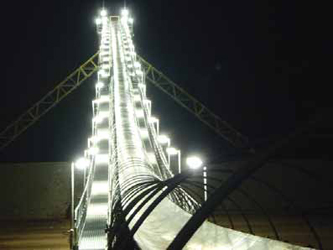 Conveyor structure at Lucara Diamond Corp.’s Karowe mine in Botswana, which
Conveyor structure at Lucara Diamond Corp.’s Karowe mine in Botswana, which
it
commissioned in 2012. The company is currently installing four more Tomra X-ray
Transmission diamond-recovery units, having already used the technology very
successfully to recover large stones.
Industrial Diamonds – The Overlooked Sector
For reasons that probably need no explanation, most peoples’
focus is invariably on gem-quality diamonds. After all, jewelers
shops sparkle on the high street; outlets for drill bits and abrasives
are usually lurking in some dark recess of an out-of-town
industrial park.
Yet there is a huge and increasing market for non-gem diamonds
as well, a market now so large that natural diamond can only supply
about 1% of world demand. The other 99% is synthetic.
In terms of mined output, gem-quality stones make up somewhere
between 20% and 30% of total annual production. The remaining
70%-80% is destined for industrial uses — and it is this
volume (around 100 million ct in 2016) that makes up the 1% of
industrial diamond that is not supplied by synthetic material.
According to the commodities research firm, Transparency Market
Research, synthetic diamond is often preferred to natural material
for industrial purposes such as grinding, cutting and polishing
diamond because its physical properties can be modified according
to end-use requirements. Developed in the 1950s, two routes
are available for producing synthetic diamonds: the HPHT (High
Pressure High Temperature) or CVD (Chemical Vapour Deposition)
processes. The HPHT system involves replicating the natural formation
process for diamonds by applying high pressure and temperature
to carbon or graphite, while the CVD process operates at low
temperatures and pressures.
Today, the main producers of natural industrial stones and bort
(fragmented material) are the DRC, Russia, Australia, Botswana
and South Africa, which supply around 80% of the world’s annual
output. By contrast, China alone accounts for around 90% of world
synthetic diamond production, with the USGS estimating its production
at some 4,000 million ct last year. To put this in perspective,
U.S. production was 125 million ct worth around $1/ct.
In the 2017 edition of its industrial diamond mineral commodity
survey, the USGS pointed out that “constant-dollar
prices of synthetic diamond products probably will continue to
decline as production technology becomes more cost effective;
the decline is even more likely if competition from low-cost producers
in China and Russia continues to increase.
Putting some figures on this outlook, Transparency Market
Research estimated that the global synthetic diamond market
was worth $15.7 billion in 2014, with the company predicting
lower costs and an increase in the number of industrial applications
for synthetic diamonds will build the market to a value of
$28.8 billion by 2023.
Big Stones Sparkle
A feature of the period since E&MJ’s last major review has been
the number of large rough diamonds that have been unearthed
— an achievement in which some smaller producers can claim
equal credit with the industry’s long-standing majors. And they
have not been slow in advertising their successes either, presumably
working on the premise that successful, well-publicized
sales of large stones will do their share price no harm at all.
For example, Gem Diamonds discovered a 314-ct stone
at its Letšeng mine in Lesotho in May 2015, and two months
later had a 357-ct diamond in its safe — later sold for $19.3 million.
Also in 2015, Lucara Diamond Corp. discovered the 342-ct
“Queen of Kalahari” at its Karowe mine in Botswana, with the
US$20.6 million stone subsequently being transformed into a
suite of six pieces of jewelry containing 23 flawless cut diamonds.
Not all sales of large diamonds are successful, though, as
was shown in May this year when the government of Sierra Leone
tried to garner interest for a 709-ct rough stone that had
been found two months earlier. The top bid of US$7.8 million
was rejected as insufficient, according to a Reuters report, although
the price offered would suggest that the diamond was
not of a quality to match its size.
Lucara was also disappointed when the 1,109-ct “Lesedi La
Rona,” the second-largest gem-quality rough diamond ever discovered,
failed to meet its expected price of at least US$70 million
in June last year, although the company gained some recompense
as its 813-ct “The Constellation” had sold for US$63
million a month before that.
Even Rio Tinto has been in on the act, with the 187.7-ct
“Diavik Foxfire” discovered during 2015. By all accounts the
stone should have been rejected and sent to waste, but its elongated
shape allowed it pass through the scalping screen. The
sale price was not disclosed.
And not to be outdone, Alrosa reported the recovery in July
of a 75-ct stone and one weighing almost 110 ct at its Mirny
operations in Russia. In 2016, the company found a 207-ct diamond
at its Zarnitsa mine, the largest recovered since open-pit
mining started there in 1999.
As featured in Womp 2017 Vol 09 - www.womp-int.com








